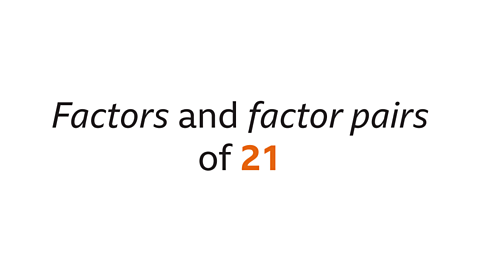Key points
factorA whole number that will divide into a selected number with no remainder. are integerIntegers are numbers with no fraction or decimal part. They can be positive, negative or zero. 42, 8, and 10000 are examples of integers. that divide exactly into a number.
Factors can be found by listing them out, using arrayAn array in maths is an arrangement of objects, numbers or pictures in columns or rows. or using factor treeA method to find the prime factors of a number by finding factor pairs.
A factor pairTwo numbers that, when multiplied together, make a selected whole number. Eg, 3 and 4 are multiplied together to make 12 so 3 and 4 are a factor pair of 12. A whole number may have one or more factor pairs. is a set of two factors. When multiplied together, the pair give a particular productThe result of multiplying one number by another, eg the product of 4 and 5 is 20 since 4 Ă— 5 = 20. A square numberA number that can be written as the product of two equal numbers. Eg, 100 is a square number as it is the result of 10 Ă— 10 has one factor pair consisting of one factor multiplied by itself.
A number that has more than two factors is a composite numberA number that has more than two factors. . This can be expressed as a unique product of prime factorsThe factors of 12 are 1, 2, 3, 4, 6 and 12. The prime factors of 12 are 2 and 3. 12 may be expressed as a product of its prime factors: 12 = 2 Ă— 2 Ă— 3 . This is useful when finding the highest common factor (HCF) The largest factor that will divide into the selected numbers. Eg, 10 is the highest common factor of 30 and 20. Highest common factor is written as HCF. (HCF) and lowest common multiple (LCM)The lowest multiple that is common to two or more numbers. The LCM of 15 and 12 is 60 because it is the lowest value in both of their multiplication tables. Also known as the least common multiple. (LCM) of large numbers.
To be able to find factors and write a number as a product of prime factors, having knowledge of powers and indices is useful.
How to find factors and factor pairs using arrays
Draw different rectangular arrayAn array in maths is an arrangement of objects, numbers or pictures in columns or rows. with the right amount of squares. Eg, to find the factors of 15, draw arrays with 15 squares
The first rectangle will always be 1 x the number you are finding factors for.
For the next rectangles, consider whether they can have a dimension of 2, 3, 4 etc. Use your understanding of divisibility rulesRecognising when a number can be divided exactly by a selected integer. Eg, any even number is divisible by 2 to help.
Each time you draw a rectangle, two factorA whole number that will divide into a selected number with no remainder. are found. These are a factor pairTwo numbers that, when multiplied together, make a selected whole number. Eg, 3 and 4 are multiplied together to make 12 so 3 and 4 are a factor pair of 12. A whole number may have one or more factor pairs.
Sometimes one of the rectangles is a square with equal side lengths. This happens when the number is a square numberA number that can be written as the product of two equal numbers. Eg, 100 is a square number as it is the result of 10 Ă— 10. The same factor is found twice - therefore only one factor is actually found. Eg, 5 Ă— 5 = 25 and 5 is a factor of 25
Remember: To find all the factor pairs, it is not necessary to draw every rectangle. Eg, a 5 x 2 rectangle and a 2 x 5 rectangle are the same rectangle in a different orientation. Only one of these rectangles is needed to get the factor pair of 2 and 5. Either rectangle can be picked.
Examples
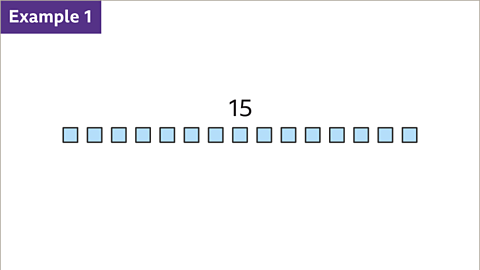
Image caption, Use arrays to find the factors and factor pairs of 15
Image caption, Draw rectangles containing 15 squares. The number of squares along each side will be a factor of 15
Image caption, These rectangles show that 1 x 15 = 15 and 15 x 1 = 15
Image caption, These rectangles show that 3 x 5 = 15 and 5 x 3 = 15
Image caption, Two unique rectangles can be drawn for 15. The 1 x 15 rectangle is the same as 15 x 1. 3 x 5 is the same as 5 x 3
Image caption, 15 is a composite number - it has more than two factors. The factors of 15 are 1, 3, 5 and 15. The factor pairs for 15 are the pairs of dimensions for each rectangle. The factor pairs of 15 are 1 and 15, and 3 and 5
Image caption, Use arrays to find the factors and factor pairs of 9
Image caption, These rectangles show that 1 x 9 = 9 and 9 x 1 = 9. These rectangles give the same factor pair, 1 and 9. Only one of the rectangles is needed - either can be picked.
Image caption, This array is a square because the sides are equal in length. The square shows that 3 Ă— 3 = 9. This gives just one factor, 3
Image caption, The unique arrays are 1 x 9 and 3 x 3. 9 is a square number and has an odd number of factors - the factors of 9 are 1, 3 and 9. The factor pairs of 9 are 1 and 9, 3 and 3
1 of 10
Question
Use arrays to find all the factors of 24
You will need a pen and paper for this.
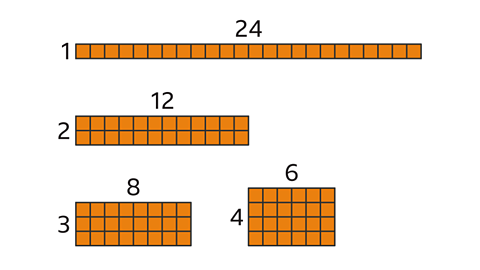
Draw different rectangular arrays with the correct amount of squares to find factors and factor pairs.
The first rectangle will always be 1 x the number you are finding factors for.
The factors of 24 are:
1, 2, 3, 4, 6, 8, 12 and 24
The factor pairs of 24 are:
- 1 and 24
- 2 and 12
- 3 and 8
- 4 and 6
How to find prime factors of a number using a factor tree
A factor treeA method to find the prime factors of a number by finding factor pairs. is made up of factor pairTwo numbers that, when multiplied together, make a selected whole number. Eg, 3 and 4 are multiplied together to make 12 so 3 and 4 are a factor pair of 12. A whole number may have one or more factor pairs. that are numbers greater than 1. A primeA whole number greater than 1 that has exactly two factors, itself and 1. Eg, 2 is a prime number (its factors are 2 and 1). 3 is a prime number (its factors are 3 and 1) number does not produce a factor tree because one of its factors is 1 and the other is itself so the number would be repeated – the factor tree would not grow.
Write the number at the top of the factor tree.
Draw two branches from the number to split the number into a pair of factors, greater than 1
Write each factor at the end of each branch.
If a factor is a prime number, the branch does not extend any further and the factor is circled to show this.
If the factor is not a prime number, it is split into a further pair of factors, greater than 1
This process continues until the branches all end in prime numbers. These are prime factorThe factors of a number that are prime. Eg, the factors of 21 are 1, 3, 7 and 21. The prime factors of 21 are 3 and 7 of the number.
Remember: the factor tree of a number can look different, but the numbers at the end of the branches will be the same.
Example
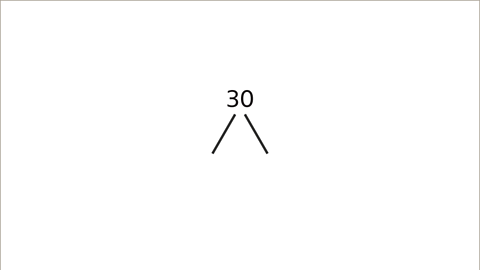
Image caption, Find the prime factors of 30 using a factor tree.
Image caption, Draw two branches from the number 30 to split it into a pair of factors, greater than 1. The factor pair could be 2 and 15, 3 and 10 or 5 and 6. The factor pair of 1 and 30 is not used because the factor 1 is not greater than 1 and the 30 is repeated.
Image caption, In this example the factor pair of 5 and 6 is used. Write each factor (5 and 6) at the end of each branch.
Image caption, 5 is a prime number so the 5 branch does not extend any further. Circle the 5 to show this.
Image caption, 6 is not a prime number so the factor tree can grow further. 6 is split into a further pair of factors, greater than 1. 2 x 3 = 6, so write the factors 2 and 3 at the end of each branch.
Image caption, 2 and 3 are both prime numbers so they can be circled. All the branches now end in prime numbers. The factor tree for 30 is complete. The prime factors are 5, 2 and 3
Image caption, The factor tree for 30 can take different forms, depending on which factors are used at the start. The prime factors are always the same. The prime factors of 30 are 2, 3 and 5
1 of 7
Question
Draw a factor tree to find the prime factors of 105
You will need a pen and paper for this.
The factor tree for 105 can take different forms, depending on which factors are used at the start.
The prime factors are always the same.
The prime factors of 105 are 3, 5 and 7
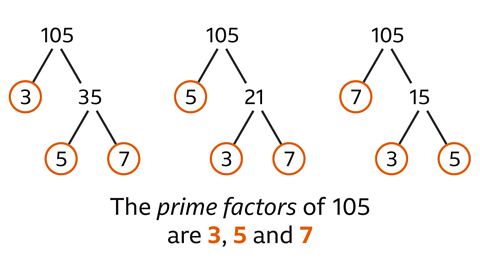
Write a number as a product of its prime factors
To write a number as a product of prime factorsThe factors of 12 are 1, 2, 3, 4, 6 and 12. The prime factors of 12 are 2 and 3. 12 may be expressed as a product of its prime factors: 12 = 2 Ă— 2 Ă— 3 , the number is written as the result of multiplying its prime factorThe factors of a number that are prime. Eg, the factors of 21 are 1, 3, 7 and 21. The prime factors of 21 are 3 and 7 together.
Draw a factor tree.
Write the number equal to the factors multiplied together in numerical order.
When a number occurs more than once, this can also be written in indexPositioned above and to the right of a number. It is an abbreviation of repeated multiplication. Eg, 7Âł means 7 x 7 x 7 form (with powers).
Writing a number as a product of its prime factors can be helpful when finding the highest common factor (HCF) The largest factor that will divide into the selected numbers. Eg, 10 is the highest common factor of 30 and 20. Highest common factor is written as HCF. (HCF) and lowest common multiple (LCM)The lowest multiple that is common to two or more numbers. The LCM of 15 and 12 is 60 because it is the lowest value in both of their multiplication tables. Also known as the least common multiple. (LCM) of large numbers.
Examples
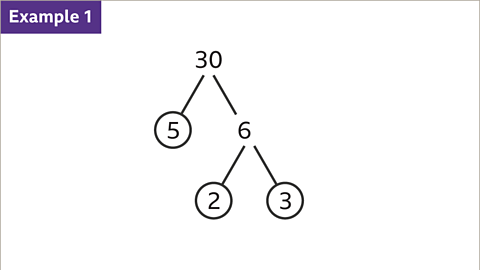
Image caption, Use the factor tree of 30 to write 30 as a product of its prime factors.
Image caption, The prime factors of 30 are 2, 3 and 5. 30 can be written as a product of its prime factors. The prime factors are written in numerical order. 30 = 2 Ă— 3 Ă— 5
Image caption, The prime factors of 24 are 2 and 3
Image caption, The prime factors of 24 are 2 and 3. 24 can be written as a product of its prime factors. The prime factors are written in numerical order. 24 = 2 x 2 x 2 x 3
Image caption, 24 as a product of prime factors can also be written in index form (with powers). This is because 2 occurs more than once. 24 = 2Âł Ă— 3
Image caption, The prime factors of 750 are 2, 3 and 5
Image caption, The prime factors of 750 are 2, 3 and 5. 750 can be written as a product of its prime factors. The prime factors are written in numerical order. 750 = 2 x 3 x 5 x 5 x 5
Image caption, 750 as a product of prime factors is 2 x 3 x 5 x 5 x 5. This can also be written in index form (with powers) as 5 occurs more than once. 750 = 2 Ă— 3 Ă— 5Âł
1 of 8
Question
Using the factor tree, write 108 as a product of its prime factors.
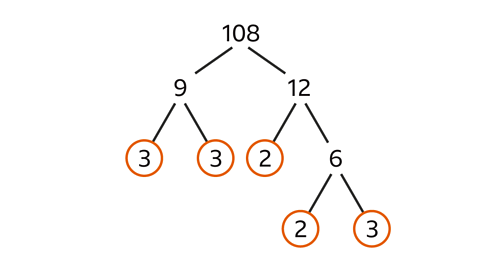
To write a number as a product of its prime factors, the number is written as the result of multiplying its prime factors together.
The prime factors in the factor tree are circled.
Write 108 as a product of its prime factors. The prime factors are written in numerical order:
108 = 2 Ă— 2 Ă— 3 Ă— 3 Ă— 3
This can also be written in index form as 2 and 3 both occur more than once:
108 = 2² × 3³
Practise finding factors
Practise what you've learned about finding the factors of a number with this quiz. You may need a pen and paper for some of these questions.
Quiz
Real-world maths
Finding factors and factor pairs can be useful in many different situations in real life.
For example, a couple are getting married and are planning their wedding. They have 72 guests coming who all need a seat. The tables can seat up to 12 people.
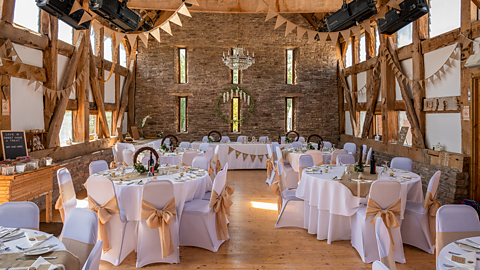
By using factor pairs, the couple can choose different combinations to suit their friends and family:
12 tables of 6 guests
9 tables of 8 guests
8 tables of 9 guests
6 tables of 12 guests

Game - Divided Islands
Play the Divided Islands game! gamePlay the Divided Islands game!
Using your maths skills, help to build bridges and bring light back to the islands in this free game from ±«Óătv Bitesize.

More on Prime numbers, factors and multiples
Find out more by working through a topic
- count3 of 4
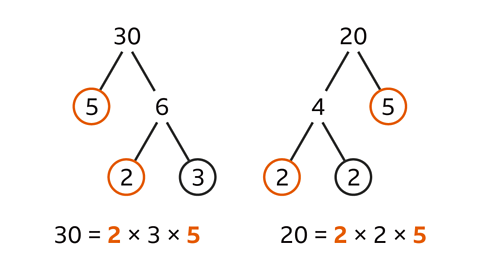
- count4 of 4
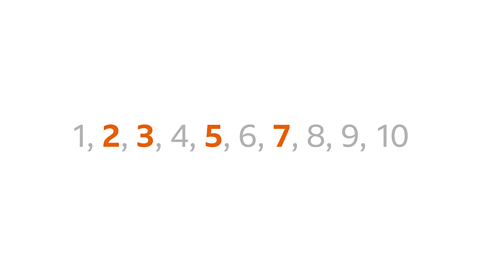
- count1 of 4
